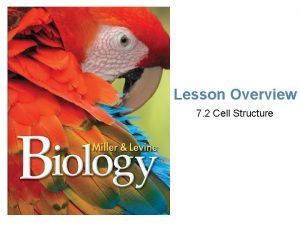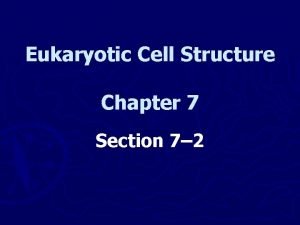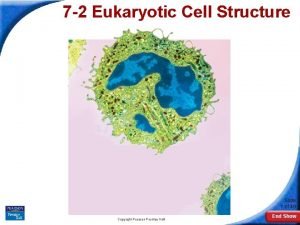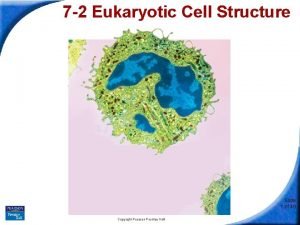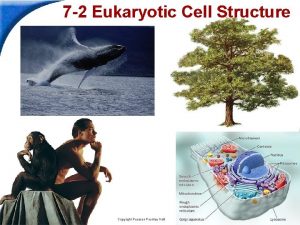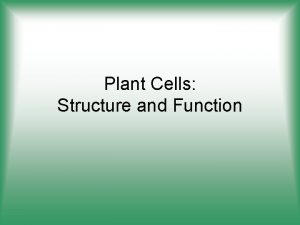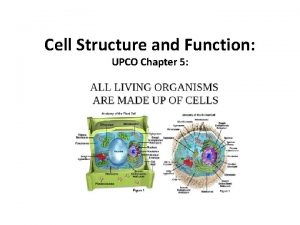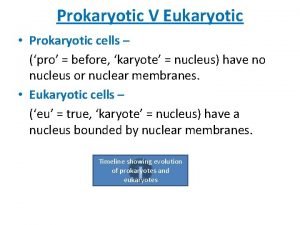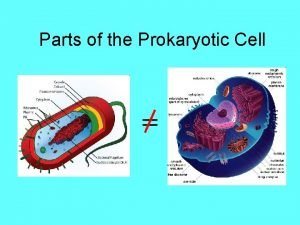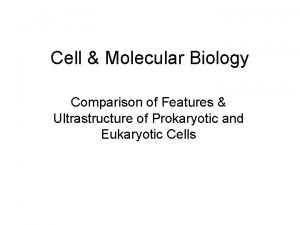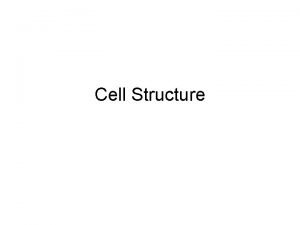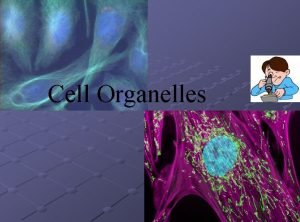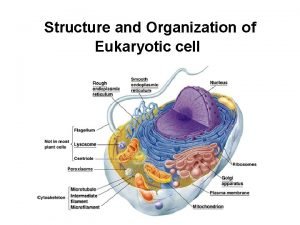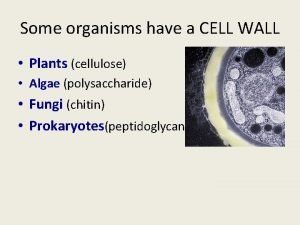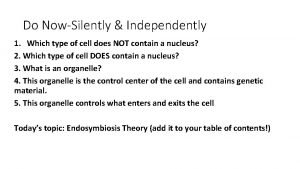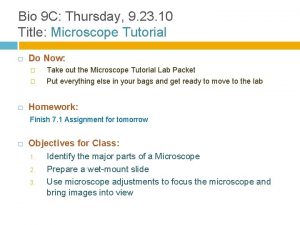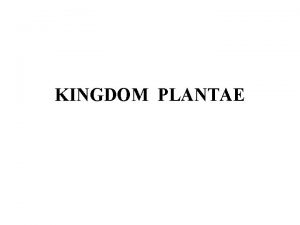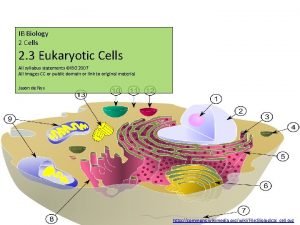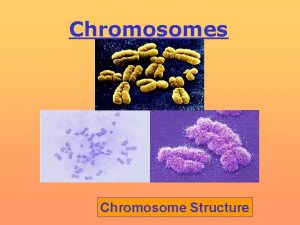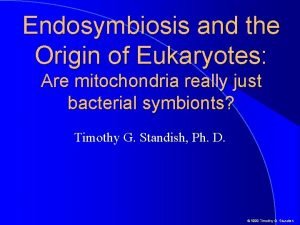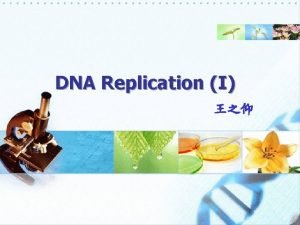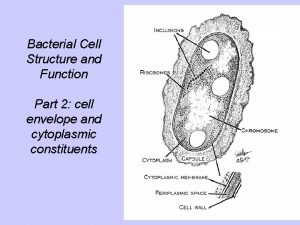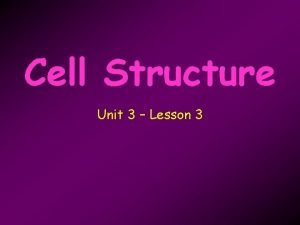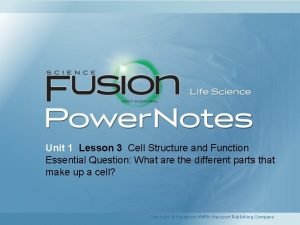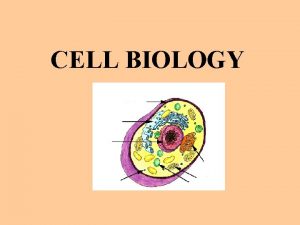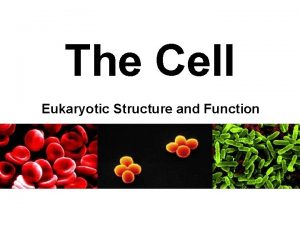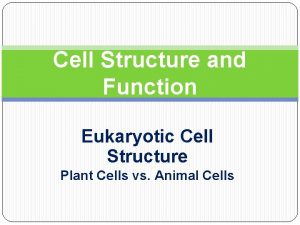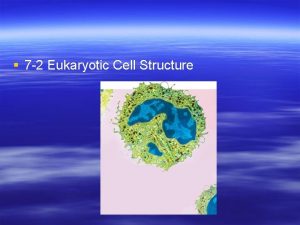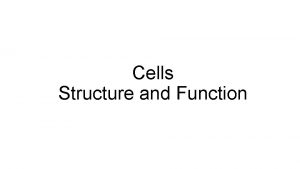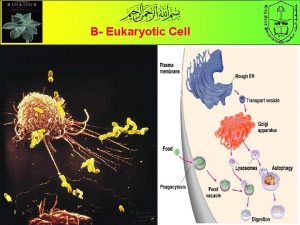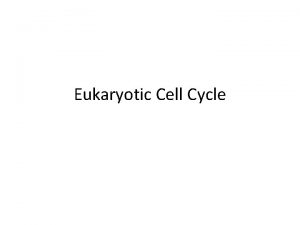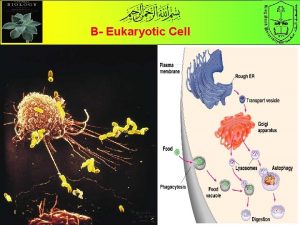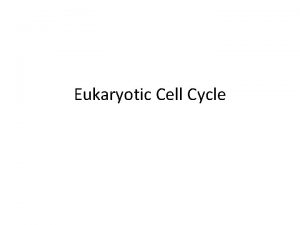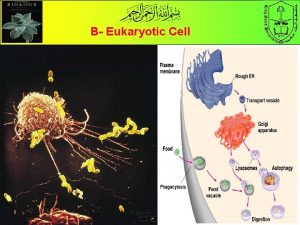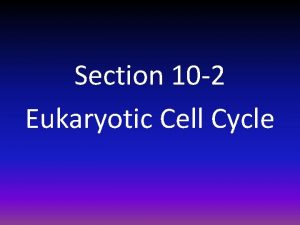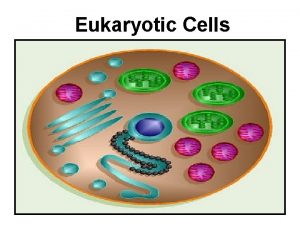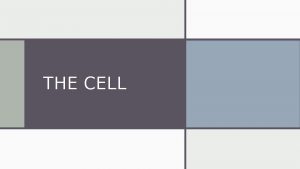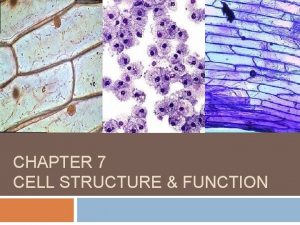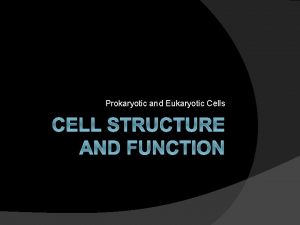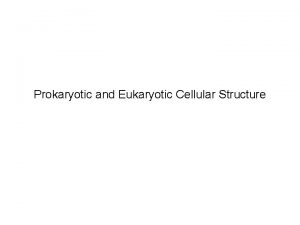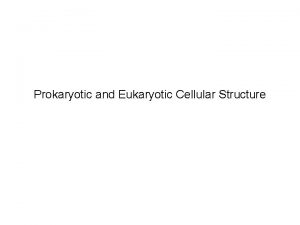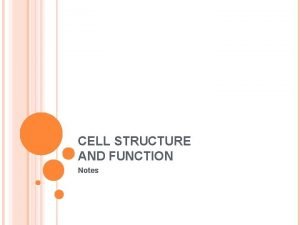Chapter 3 Cell Structure and Function Eukaryotic Cell






































- Slides: 38

Chapter 3 Cell Structure and Function

Eukaryotic Cell Structure

Chemical Components of Cells • Most cells are composed of 4 elements – Carbon – Hydrogen – Oxygen – Nitrogen • Cells are about 60% water

Anatomy of a Generalized Cell • Cells have 4 main regions (parts) – Nucleus – Cytoplasm – Plasma Membrane

Nucleus • Control center • Cell reproduction DNA --Visible Chromosomes • Nuclear envelope – Double membrane – Pores • Nucleoli – r. RNA and t. RNA assembly

Cell Membrane-fluid mosaic • Controls movement into and out of the cell • Composed of – – lipid and protein bilayer Cholesterol Glycolipids Glycoproteins

Components of Cell Membrane (Fluid Mosaic Model) • Phospholipids (bilayer) – Phospholipids • Hydrophillic (water loving) Head: Phosphate and glycerol • Hydrophobic Tails (water hating): impermeable to most water soluble molelcules • Cholesterol – membrane fluidity • Proteins: Receptors, enzymes, transport channels or carriers • Receptors: Glycoproteins and Glycolipids – Blood type, organ transplant rejection

ORGANELLES • Specialized cellular compartments • Many membrane bound

Cytoplasm (Cytosol) • Semi-fluid material suspends other elements • Contains enzymes

Mitochondrion • Double membrane – Internal folds • Cellular Respiration!!! Energy for cell • Contains its own DNA and RNA

Ribosomes • Site of Protein synthesis • Found – free in cytoplasm – As a part of the Rough ER

Endoplasmic Reticulum • Fluid Filled Tubules • Rough ER – Contains Ribosomes – Moves proteins within cell • Smooth ER – No Ribosomes – Protein modification – Lipid metabolism

Rough ER

Golgi Apparatus • Flattened sacs • Modifies, Sorts, and packages proteins arriving from ER for delivery

Golgi Animation Materials are transported from Rough ER to Golgi to the cell membrane by VESICLES 15

3 types of packages

Lysosomes • Intracellular digestion (enzymes) • Membranous “bags” from golgi apparatus • Fuse with vesicles – Ingested food – Damaged organelles Tay-Sachs disease-missing or inactive lysosomal enzymes

Cytoskeleton • Protein network made of… – Microfilaments – intermediate filaments – Microtubules • Cell Shape • Internal Organization • Organelle Movement!

Figure 3. 7 Cytoskeletal elements support the cell and help to generate movement. (a) Microfilaments (b) Intermediate filaments (c) Microtubules Tubulin subunits Fibrous subunits Actin subunit 7 nm Microfilaments form the blue batlike network. 10 nm Intermediate filaments form the purple network surrounding the pink nucleus. 25 nm Microtubules appear as gold networks surrounding the cells’ pink nuclei.

Centrioles • Rod shaped made of Microtubules • Before mitosis-pairs duplicate + separate – Produces Mitotic Spindles

Cilia and Flagella • Cell movement – Sperm cells-flagella • Movement of materials along surface – Respiratory tract-cilia • Microvilli – fingerlike extensions – Increase surface area for absorption

Cilia Moving Away Dust Particles from the Lungs Respiratory System 22

Membrane Transport • Two basic methods – Passive Transport (no energy required) – Active Transport (energy required ATP)

Passive Transport • Diffusion – Simple: lipid soluble or small – Osmosis: water moves thru aquaporins – Facilitated: use carriers – Filtration

Passive Transport: Filtration • Water and solutes are forced through a membrane because of a pressure gradient • Through capillary walls – Movement of water or small solutes – Kidneys-blood filtration

Active Transport • Solute pumping • Requires protein carriers • ATP used Examples: sodium/potassium pump

Active Transport • Endocytosis: into the cell – Phagocytosis: engulfing large particles – Pinocytosis: cell drinking • Exocytosis: movement out of the cell

Figure 3. 12 b Exocytosis. (b) Electron micrograph of a secretory vesicle in exocytosis (190, 000×)

Figure 3. 13 b Events and types of endocytosis. Extracellular fluid Pseudopod (b) Cytoplasm Bacterium or other particle

Figure 3. 13 a Events and types of endocytosis. Slide 4 Extracellular fluid Cytosol Vesicle 1 Vesicle fusing with lysosome for digestion Plasma membrane Lysosome Release of contents to cytosol 2 Transport to plasma membrane and exocytosis of vesicle contents Detached vesicle Ingested substance Pit (a) 3 Membranes and receptors (if present) recycled to plasma membrane

Cell Life Cycle • INTERPHASE – Cell growth – Carries on regular cell activities • CELL DIVISION – Cell replicates itself to produce more cells for growth and repair

Interphase • G 1: “growth” – protein synthesis, organelles double • S: “synthesis” phase – DNA replication/duplicated chromosomes • G 2: – Protein synthesis, chromatin condenses, chromosomes visible, final preparation to divide


Cell Division • Mitosis – division of the nucleus – Result: 2 daughter nuclei • Cytokinesis – division of the cytoplasm – Result: 2 daughter cells

Figure 3. 15 Stages of mitosis. Slide 1 Centrioles Chromatin Centrioles Forming mitotic spindle Plasma membrane Interphase Nuclear Chromosome, envelope consisting of two Nucleolus sister chromatids Early prophase Spindle microtubules Centromere Fragments of nuclear envelope Spindle pole Late prophase Nucleolus forming Metaphase plate Cleavage furrow Spindle Metaphase Sister chromatids Daughter chromosomes Anaphase Nuclear envelope forming Telophase and cytokinesis

Cytokinesis • Division of cytoplasm • Cell pinched into 2 daughter cells

Protein Synthesis (into) DNA m. RNA Protein transcription translation

Figure 3. 16 Protein synthesis. Slide 1 Nucleus (site of transcription) Cytoplasm (site of translation) DNA 1 m. RNA specifying one polypeptide is made on DNA template. Amino acids m. RNA Nuclear pore Nuclear membrane Correct amino acid attached to each species of t. RNA by an enzyme 4 As the ribosome moves along the m. RNA, Met a new amino acid is Gly added to the growing protein chain. Ser Growing polypeptide chain Phe Ala 5 Released t. RNA reenters the cytoplasmic pool, ready to be recharged with a new amino acid. Peptide bond 2 m. RNA leaves nucleus and attaches to ribosome, and translation begins. Synthetase enzyme 3 Incoming t. RNA recognizes a complementary m. RNA codon calling for its amino acid by binding via its anticodon to the codon. t. RNA “head” bearing anticodon Large ribosomal subunit Direction of ribosome advance; ribosome moves the Portion of m. RNA strand along m. RNA already sequentially as each translated codon is read. Small ribosomal subunit Codon
 Prokaryotic cell and eukaryotic cell similarities
Prokaryotic cell and eukaryotic cell similarities Prokaryotic cell and eukaryotic cell
Prokaryotic cell and eukaryotic cell Prokaryotic vs eukaryotic cell
Prokaryotic vs eukaryotic cell Carbohydrate side chain
Carbohydrate side chain Eukarya
Eukarya Eukaryotic cell structure
Eukaryotic cell structure Most nuclei contain a small dense region known as the
Most nuclei contain a small dense region known as the Eukaryotic cell structure
Eukaryotic cell structure Eukaryotic cell
Eukaryotic cell Section 7-2 eukaryotic cell structure
Section 7-2 eukaryotic cell structure Mitochordrion
Mitochordrion Eukaryotic plant cell
Eukaryotic plant cell Chapter 7 cell structure and function section review 7-2
Chapter 7 cell structure and function section review 7-2 Chapter 5 cell structure and function
Chapter 5 cell structure and function Prokaryotic
Prokaryotic Amoeba prokaryotic or eukaryotic
Amoeba prokaryotic or eukaryotic Typical eukaryotic cell
Typical eukaryotic cell Eukaryotic cell organisation
Eukaryotic cell organisation Difference between prokaryote and eukaryotes
Difference between prokaryote and eukaryotes Eukaryotic cell diagram
Eukaryotic cell diagram Lipshutz bodies
Lipshutz bodies Eukaryotic cell
Eukaryotic cell Do seedless plants have cell walls made of cellulose
Do seedless plants have cell walls made of cellulose Plant cell
Plant cell Eukaryotic cell with labels
Eukaryotic cell with labels Eukaryotic cell
Eukaryotic cell Ib biology eukaryotic cell diagram
Ib biology eukaryotic cell diagram Prokaryotic cells
Prokaryotic cells How to read chromosome
How to read chromosome What happens in telophase
What happens in telophase Eukaryotic chromosome structure
Eukaryotic chromosome structure Eukaryotic chromosome structure
Eukaryotic chromosome structure Bacterial cell structure and function
Bacterial cell structure and function Lesson 3 cell structure and function answer key
Lesson 3 cell structure and function answer key Organelle graphic organizer
Organelle graphic organizer Animal vs plant cell venn diagram
Animal vs plant cell venn diagram Lesson 3 cell structure and function answer key
Lesson 3 cell structure and function answer key Cell organelle graphic organizer answer key
Cell organelle graphic organizer answer key Plastids in plant cell
Plastids in plant cell





